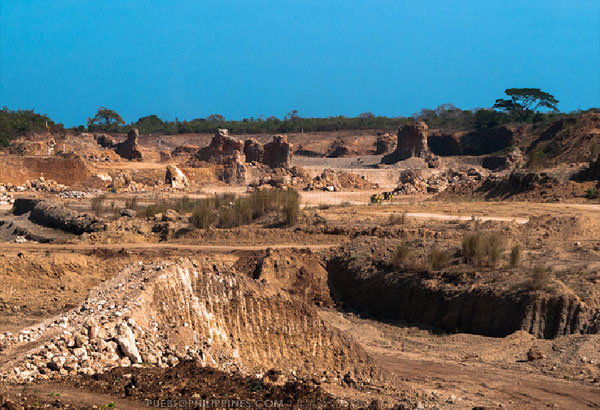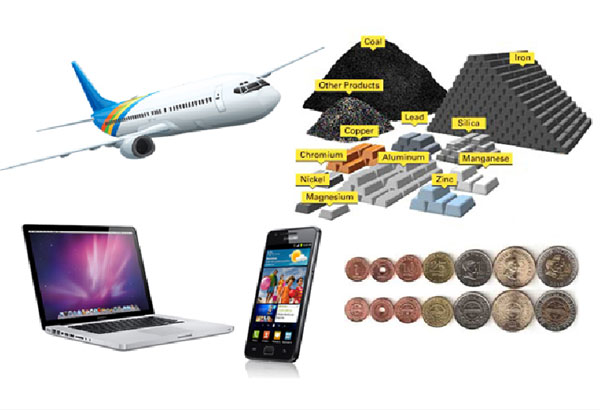Can anything good come out of mining?

An example of a large-scale mining site. Danny Jovica
It is difficult to lose the irony in asking this question as I type this article on my laptop, send it to my editor via email, and have the piece later read on a mobile phone. All of the gadgets in my example are products of mining industries that have developed the technology to extract minerals from the earth and convert them into things that are not only useful but altogether ubiquitous in our daily lives. Communications and the rise of the Internet are just examples of areas where mining has enabled great advancements in technology and altered the ways in which we live -- almost completely. Today, great chunks of our lives are no longer wasted at sea or on land when we move from place to place. Flying in aircrafts and moving in automobiles that use aluminum, steel, molybdenum and other minerals cut travel time to a minimum. Even in small households, mining makes a dent through our telephones, cleaning products, refrigerators and television sets with LCD screens -- all of which, we must admit, we would not enjoy without the mining of minerals.
Considering how immersed we are in the use of these products, it is no surprise that mining touches on economic, social and political concerns. Adding to this is the unique placement of the Philippines on the map that has caused the archipelago to play host to a rich biodiversity. Minerals abound, and research by the Department of Environment and Natural Resources (DENR) implies that we have on our isles an embarrassment of riches such that any smart businessman intent on creating value and revenue will, in one way or another, see the potential of the mining industry to bring growth to our economy.

Products from the mining industry.
In a mining forum held three years ago, Manuel V. Pangilinan, Chairman of the Philippine Long Distance Telephone company, made a strong case for mining that encouraged the country’s leadership to consider increasing investments in the sector. He argued that, as the 5th most mineralized country in the world, the Philippines not only had the potential to establish world-class mines but also compete globally and yield profit for Filipinos. Moreover, he challenged the use of common sense, asserting that the country’s decision to cease from mining does nothing to curb the consumer’s appetite for its products. According to him, it would cost more for the Philippines to import these products, whether raw or manufactured, as opposed to producing them here in our own backyard.
Reasonable as these arguments might sound, they invite a probe into the definition of wealth and progress as it relates to communities where mining operations have taken place. It also begs the question: who benefits from the yield of mining anyway? If mineral wealth in the Philippines is estimated at $840 billion, how much of those assets are invested in the communities affected by mining? Most importantly, is this figure reflective of the social and environmental costs wrought by diggings and excavations?
Past examples have painted a rather dire picture of how mining can transform environments and negatively affect communities. In 2012, fish kill in Lake Bito, Leyte, was traced to mine wastes from Nicua Mining Corporation (NMC), then operating in MacArthur, Leyte. The Mines and Geosciences Bureau (MGB), the government entity under DENR responsible for regulating mining activities in the country, later suspended NMC’s operations following the fish kill. However firm the penalty, the damage had ultimately been done and when faced with the sudden mass mortality of fish due to the contamination of waters, it is difficult to imagine how the people living in the environs of Lake Bitoeventually recovered.

Fish kill in Lake Bito. Photo by myslugline
In August of the same year, Pangilinan’s Philex Mining Corporation operating in Padcal mines in Benguet endured a huge waste spill with about 20 million metric tons of tailings gushing out of its tailings-pond, surpassing the 1996 Marinduque Marcopper spill of 4 million metric tons. The Philex discharge ran into the Balog and Agno River systems and later the San Roque Dam, provider of water for agricultural irrigation and power-generation serving a number of municipalities in Pangasinan. Philex paid a record fine of P1.034 billion as per the assessment of the MGB to compensate for the violation of the Mining Act of 1995. An additional P188.6 million was paid for the violation of the Clean Water Act. These are, by industry standards, big premiums for corporations to pay, but the question remains: can the money fund the regeneration of land pillaged and waterways polluted?
Another case in 2014 involved having the MGB close the Cantilan and Carrascal nickel mines of Marcventures Mining and Development Corporation (MMDC) for their failure to maintain environmental mitigation measures. The moratorium won small farmers and fisher folk a temporary victory. Not long after, the suspension order was lifted from the Cantilan mine after MGB certified that the company had completed and implemented environmental safeguards. While it is the function of legislation and regulatory bodies like the MGB to uphold the law, cases like these make me wonder if we might also question the scope of the law beyond its technicalities. In other words, can we review existing legislation around mining and determine if specific policies are still relevant to their respective polities? Where regulation and the implementing rules are concerned, I wonder if studies have been done to establish the impacts of small-scale mining on habitats? As these projects occur in hundreds of sites without a central entity that can serve to be accountable for damages incurred, we run the risk of focusing too much attention on large mining corporations without adequately exerting responsibility over small players whose influence on communities can sometimes be equally detrimental. Consider, for instance, the exposure of children as laborers in small mining operations where compression shafts are always threatening to collapse. Tragically, children are often exploited in both small and large operations. When lives are lost in these circumstances, which entities stand to be held accountable?
In assessing the climate of mining in the Philippines, another important area of concern is awareness and education. Deforestation is a feature of large-scale mining, which erodes upland watersheds and dumps enormous amounts of soil into downstream waterways. Proponents and dissidents of mining have both argued over the amount of actual forest cover affected by quarrying and excavations. Several private corporations have gone as far as including massive tree-planting activities in their Corporate Social Responsibility portfolios, while environmentalists have held their ground, asserting that these programs do not adequately respond to the alterations done on the land. This ongoing debate and a sense of over-saturation of mining operations has prompted some groups to call for a total ban on mining until the correct information detailing the conditions of the environment and determining the extent of the damage can be assessed. This is a welcome proposal, especially when emotions run high and both sides seem intent on the extremes of either banning mining altogether or allowing the status quo altogether, with little appreciation for other variables like the social cost of the mining enterprise. The importance of proper documentation and the accessibility of information on our environmental assets and their management through corporations, all under the auspices of the state, cannot be overlooked. As arguments stand today, only clear data can support claims by either side and give the discerning public the capacity to answer the question that this article primarily poses. Can something truly good come out of mining?
The ease of living in a technologically advanced world dulls one’s senses but a bigger part of me remains concerned about the collateral damage. Recent reports on the brutal killings of lumad leaders Emerito Samarca, Dionel Campos and Datu Juvello Sinzo in the hands of paramilitary groups come to mind. Though the particulars of the case have not yet been threshed out, some allegations have been made against mining companies operating in Surigao del Sur. It is believed that paramilitary forces do the bidding for these corporations and so have a hand in the murders. The evidence will have to prove as much but the precariousness of their life is what strikes one most. Historically, the lumad peoples of Mindanao, composed of 18 ethno-linguistic groups, have been relegated to the margins and, on several occasions, stripped of their land despite legislation on ancestral domain that should have favored them. As indigenous peoples, their inclusion in society has been unfairly hinged on their ability to enter the modern trends of consumption. Consequently, populations of lumad are regarded as impoverished and backward. They often fall prey to economic interests with little consideration for their own ways of life, which are tightly bound to the land and the environment that sustains them.
Given these considerations, it is not difficult to see how mining poses serious challenges that cannot simply be swept away in the name of national development and consumer convenience. The industry is first and foremost a business that will invariably place profit above people and the environment. The corporate and trans-national ownership of these mines -- and the laws that protect their activities -- often mean that there is little accountability and even less responsibility for the serious damages mining operations do. If there is any hope for mitigating the problems that arise in the mining industry, it would necessarily entail the active participation of those communities directly affected, and often damaged, by their violent workings. The question remains: can a combination of better laws and democratic participation by local communities make “responsible mining” more of a reality?
- Latest
- Trending
























